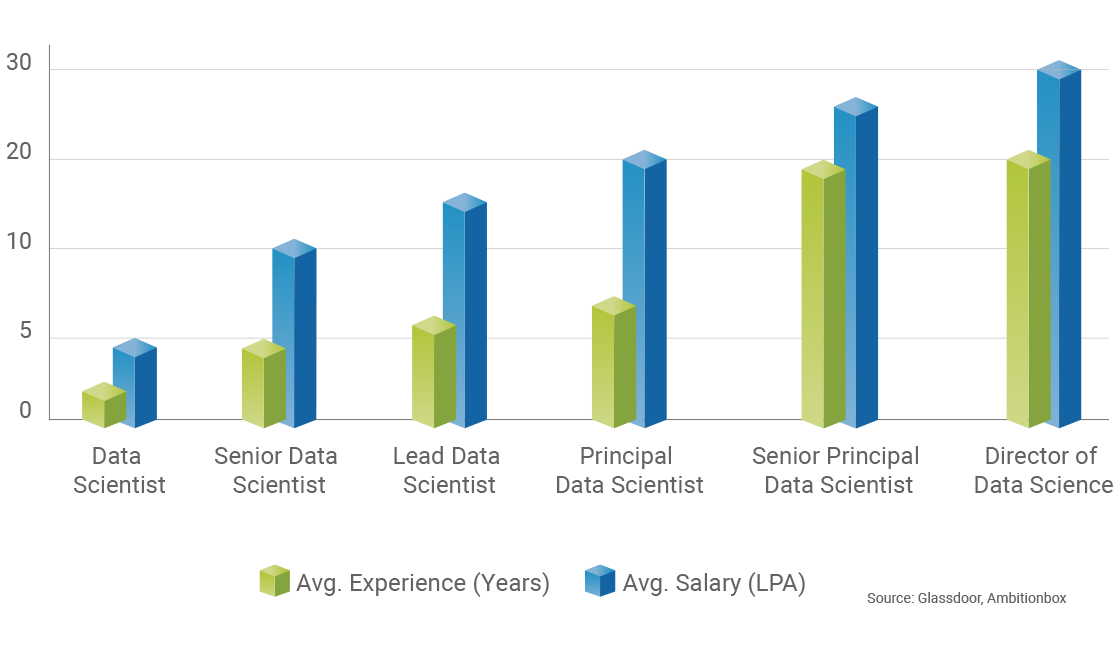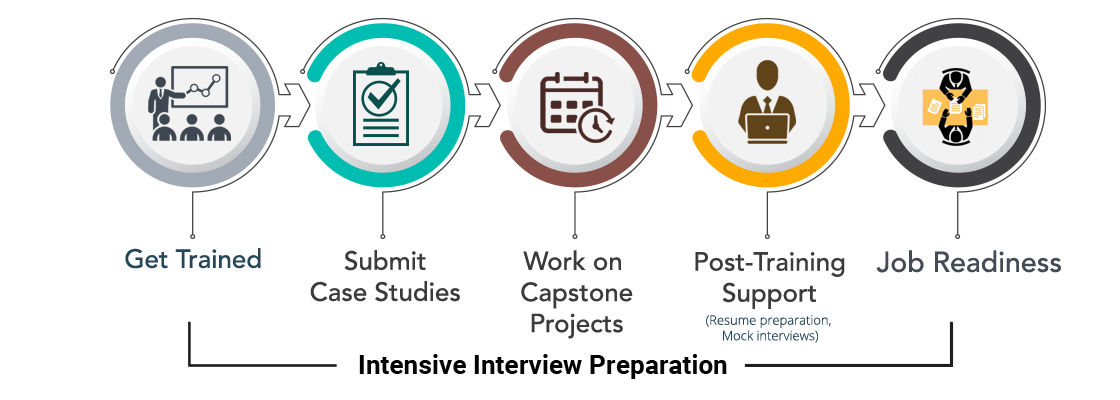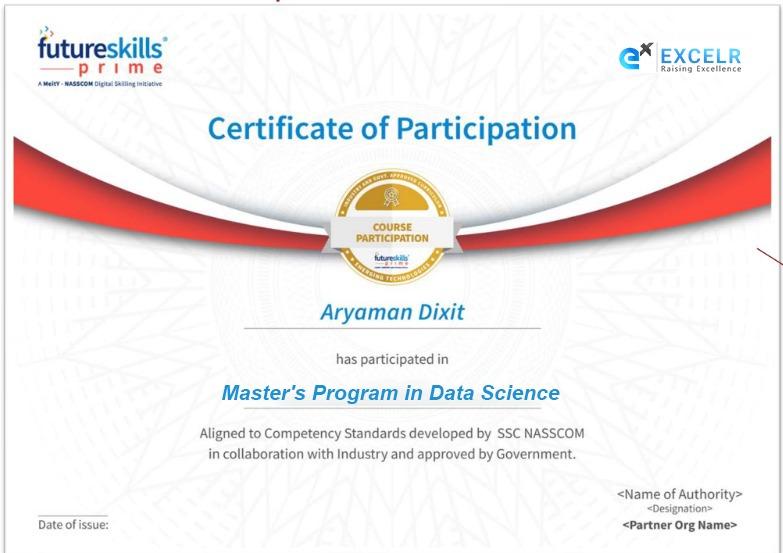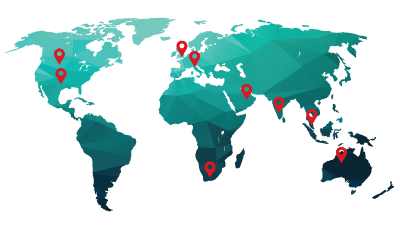Course Description
Data Science Certification from IITM Pravartak:
Accelerate your career with Data Science certification from IITM Pravartak, one of the leading universities in India. This data science course in Mumbai is a perfect blend of theory, case studies and capstone projects. The course curriculum has been designed by IITM Pravartak and considered to be the best in the industry. Get noticed by recruiters across the globe with the international certification. Post certification one will gain the alumnus status in IITM Pravartak.
What is the certification process?
Post completion of the training, one should take an online examination facilitated by the university and should attain 60% or more to complete the course and gain the certification. Subsequently participants can check their alumnus status on IITM Pravartak.
Advanced Certification Program in Data Science and AI for Digital Transformation from IITM Pravartak:
ExcelR, in association with IITM, brings to you an add-on certification for your Data Science Course in Mumbai
This certification program provides you with:
- 15+ Hours of Interactive Live-Virtual Sessions by professors of IITM.
- Optional 2-day Campus Immersion in the beautiful, state-of-the-art IITM.
- A prestigious IITM Pravartak Certificate.
What is the certification process?
During the period of your data science course in Mumbai, interactive live-virtual sessions will be conducted by professors of IITM. An optional campus immersion will also be planned, whereby a slot will be created, and you will travel to Chennai for a two-day experience at the IITM campus. Post training, you will take a short quiz on the topics discussed in the session, which will unlock your Advanced Certification in Data Science and AI for Digital Transformation from IITM Pravartak.
Data Science Course Training
ExcelR offers the most comprehensive data science course in Mumbai course market, covering the complete Data Science lifecycle concepts from Data Collection, Data Extraction, Data Cleansing, Data Exploration, Data Transformation, Feature Engineering, Data Integration, Data Mining, building Prediction models, Data Visualization and deploying the solution to the customer. Skills and tools ranging from Statistical Analysis, Text Mining, Regression Modelling, Hypothesis Testing, Predictive Analytics, Machine Learning, Deep Learning, Neural Networks, Natural Language Processing, Predictive Modelling, R Studio, Tableau, Spark, Hadoop, programming languages like R programming, Python are covered extensively as part of this Data Science training. ExcelR is considered as the best Data Science training institute which offers services from training to placement as part of the Data Science training program with over 400+ participants placed in various multinational companies including E&Y, Panasonic, Accenture, VMWare, Infosys, etc. ExcelR imparts the best Data Science training and considered to be the best in the industry.
Why Should You Choose ExcelR For Your Data Science Certification Course in Mumbai?
If you are serious about a career pertaining to Data science, then you are at the right place. ExcelR is considered to be one of the best Data Science training institutes. We have built careers of thousands of Data Science professionals in various MNCs in India and abroad. “Training to Job Placement” – is our niche. We do the necessary hand-holding until you are placed. Our expert trainers will help you with upskilling the concepts, to complete the assignments and live projects.
ExcelR has a dedicated placement cell and has partnered with 150+ corporates which will facilitate the interviews and help the participants in getting placed. ExcelR is the training delivery partner in the space of Data Science for 5 universities and 40+ premier educational institutions like IIM, BITS Pilani, Woxen School of Business, University of Malaysia, etc. Faculty is our strength. All of our trainers are working as Data Scientists with over 15+ years of professional experience. Majority of our trainers are alumni of IIT, ISB and IIM and a few of them are PhD professionals. Owing to our faculty, ExcelR’s certification is considered to be the best Data Science certification offered in this space. ExcelR offers a blended learning model where participants can avail themselves classroom, instructor-led online sessions and e-learning (recorded sessions) with a single enrollment. A combination of these three modes of learning will produce a synergistic impact on learning. One can attend an unlimited number of instructor-led online sessions from different trainers for 1 year at no additional cost. No wonder ExcelR is regarded as the best Data Science training institute to master Data Science concepts and crack a job.
What Is Data Science? Who Is Data Scientist?
Data Science is all about mining hidden insights of data pertaining to trends, behaviour, interpretation and inferences to enable informed decisions to support the business. The professionals who perform these activities are said to be a Data Scientist / Science professional. Data Science is the most high-in-demand profession and as per Harvard and the most sort after profession in the world.
Why Should One Take The Data Science Course in Mumbai?
Is Data Science certification being worth pursuing as a career?
The answer is a big YES for myriad reasons. Digitalization across the domains is creating tons of data and the demand for the Data Science professionals who can evaluate and extract meaningful insights is increasing and creating millions of jobs in the space of Data Science. There is a huge void between the demand and supply and thereby creating ample job opportunities and salaries. Data Scientists are considered to be the highest in the job market. Data Scientist career path is long-lasting and rewarding as the data generation is increasing by leaps and bounds and the need for the Data Science professionals will increase perpetually.
- 1.4 Lakh jobs are vacant in Data Science, Artificial Intelligence and Big Data roles according to NASSCOM
- The world will notice a deficit of 2.3 Lakh Data Science professionals by 2021
- The Demand for Data Scientist professionals has increased by 417% in the year 2018, in India, as per the Talent Supply Index
- Data Science is the best job to pursue according to Glassdoor 2018 rankings
- Harvard Business Review stated that ‘Data Scientist is the sexiest job of the 21st century’
You May Question If Data Science Certification Is Worth It?
The answer is yes. Data Science / Analytics creating myriad jobs in all the domains across the globe. Business organizations realised the value of analysing the historical data in order to make informed decisions and improve their business. Digitalization in all the walks of the business is helping them to generate the data and enabling the analysis of the data. This is helping to create myriad data science/analytics job opportunities in this space. The void between the demand and supply for the Data Scientists is huge and hence the salaries pertaining to Data Science are sky high and considered to be the best in the industry. Data Scientist career path is long and lucrative as the generation of online data is perpetual and growing in the future.
Why ExcelR Is The Best Data Science Training Institute?
ExcelR offers the best Data Science certification online training along with classroom and self-paced e-learning certification courses. The complete Data Science course details can be found in our course agenda on this page.
Who Should Do The Data Science Course?
Professionals who can consider data science course in Mumbai with placement assistance as a next logical move to enhance in their careers include:
- Professional from any domain who has logical, mathematical and analytical skills
- Professionals working on Business intelligence, Data Warehousing and reporting tools
- Statisticians, Economists, Mathematicians
- Software programmers
- Business analysts
- Six Sigma consultants
- Fresher from any stream with good Analytical and logical skills
Interview Preparation Sessions
Participants who have completed the Data Science course in Mumbai and the projects will be put under our Placement Incubation Program. As part of this program, participants will undergo a thorough interview preparation process on Data Science. A huge repository of Data Science Interview questions with answers will be provided for the participants to prepare. A dedicated Data Science Subject Matter Expert (SME) will help in resume building, conduct mock interviews and evaluate each participant's knowledge, expertise and provide feedback. Our SMEs will do the necessary handholding on interview preparation process till the time the participant is placed. Guidance is also provided on Linkedin profile building and tricks of the trade to improve the marketability of the resume. - ExcelR Management
Projects Covered in ExcelR Data Science Course in Mumbai
- As more and more people are expressing their views and opinions on various microblogging websites about various products and services. There has been a surge of data generated by the users, these websites have people sharing their thoughts daily.
- Sentiment Analysis with the help of Natural Language Processing technique for identifying the sentiments of a product or service
- Customers are looking for more information before buying a product on E-commerce websites. Amazon introduced a new feature 'question and answer' search field for products.
- The project is to build an information retrieval system from Amazon products data based on NLP techniques. Top 5 relevant answers to be retrieved based on input question
- Reducing the risk of fraudulent loans by carefully evaluating the risk & at the same time increasing profits by rejecting only those loans, which have the potential of defaulting
- The objective of the analysis to predict an item when sold, what is the probability that customer would file for warranty and to understand important factors associated with them
- Predict which flights would be delayed and by how long?
- Flight delays cost the industry an estimated $25 billion every year More than 60 percent of frequent flyers cite delays among the things about air travel that they find most dismaying. And the costs are spread around - an extra $25 in parking here, a missed business meeting there. Carriers, meanwhile, pay an estimated $62 per minute in crew, fuel, maintenance and other costs. It adds up.
Career Progression and Salary Trends

Learning Path

Course Curriculum
Data Science
- What is Data Science? Use cases with Business Problem (Mobile/Banking) and How ML gives a solution, Types of Roles, what learnings are important, VAC courses offers, Jumbo Pass, Q & A.
- ML Project Life Cycle(Problem, Collecting the data, EDA,Cleaning,Transformation, Partition, Model fitting, Cross validation, Metrics, Deployment),
- Sample, population, Data types(continous, discrete), Central tendency, spread, shape of the data such histogram, skewness, kurtosis
- Bargraph, Box plot(IQR, Whisker lengths, outliers), Scatter plot( Positive , Negative, Neutral), correlation
- Intro to Python language,Anaconda Installation(Jupyter, Spyder), Datatypes(Int, Float,dic,Set), operators(Arthemetic,comparision,Logical, Assignment)
- Data structures(List (types of list methods such as append ,extend ,insert ,remove ,pop ,clear ,index ,count ,sort ,reverse), tuples,dictionary,set), What are Control structures (if, ifelse, if elif, Nested if)
- For loop, functions, numpy(scalar,array, vector, 1 dim, 2 dim, random int), converting numpy to pandas, giving column names, Importing pandas, (read_csv, head, tail, describe)
- Pandas (info, selecting columns, dropping columns, groupby, concat(row and columns),merge, removing duplicates, filling blanks with mean)
- EDA (showing graphs such as histogram, boxplot, bargraph, scatter plot, heat map using matplotlib, seaborn) using Google collab with generative AI usage. Giving an example dataset ask them to work in class
- Probability, Normal distribution theory, standardization, zscore, z tables, applications, python code, confidence Interval
- Level of significance, Hypothesis Testing (One sample Z test, Two sample Z test), t-test
- Simple Linear Regression, metrics such RMSE and R square - Working on Age vs Weight example
- Intro to Regression models , MLR - Assumptions of Linear Regression, Variable selection, Multicollinearity VIF
- what is meant by classification models ? When do we choose Logistic regression, modelfitting, confusion matrix, accuracy score - Working on Breast cancer case study
- Other metrics Sensitivity, Specificity, precision , F1 score, ROC curve, AUC score
- Data Transformation(Standardard scaler, minmax scaler, label encoding, one hot encoding) and Data partition (Training and Test)
- Cross validation (Stratified K-Fold, K-Fold cross validation,Shuffle Split Cross-Validation)
- Variance Biased Trade-off(under fitting-causes-Lack of training , best fit, over fitting - causes -Noise in training data,Too many training epochs or iterations, too many variables) ,Visualizations (Underfitting ,bestfit, Overfitting) and Feature Engineering - Working on Bangalore housing prices case study
- Techniques such Lasso, Ridge, ElasticNet - Working on "Banglore housing prices" case study.
- Support vector machine (Hyperplane, Maximum margin classifier, Support Vectors, SVM for Linear Classification , SVM for Non-Linear Classification(polynomial, RBF, Sigmoid)
- Decision Tree Structure(Root node,Internal nodes,terminal nodes),Gini Impurity, Entropy and Information Gain (for classification), Overfitting and Underfitting in Decision Trees, Pruning,Hyperparameters - Working on Sales data set using python
- Ensemble Methods: Bagging and Random forests , working on hyper parameters to control overfitting.
- Sequential methods: Gradient Boosting, Ada Boost, using Grid search CV
- XG Boost, LightGBM
- Final project with Deployment
- What are DImensional Reduction Techniques ? 1. Purpose of PCA 2. Eigenvectors/Eigen values 3. Applications 4. Advantages 5. Working on case study
- Introduction to Clustering, Distance Metrics,Clustering Algorithms(K mean, dbscan),Choosing the Right Number of Clusters(Elbow Method,Silhouette Analysis)
- what is Recommendation and why it is important? What is Collaborative Filtering (CF) And Content-Based Filtering ?
- Time series Concepts, components, Visualization,Data partition, Lagplot, ARIMA models,Python code on ARIMA models
- Perceptron , Single Layer Network, activation functions, Back propagation method,
Contact Our Team of Experts














